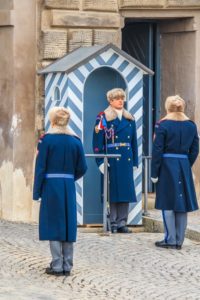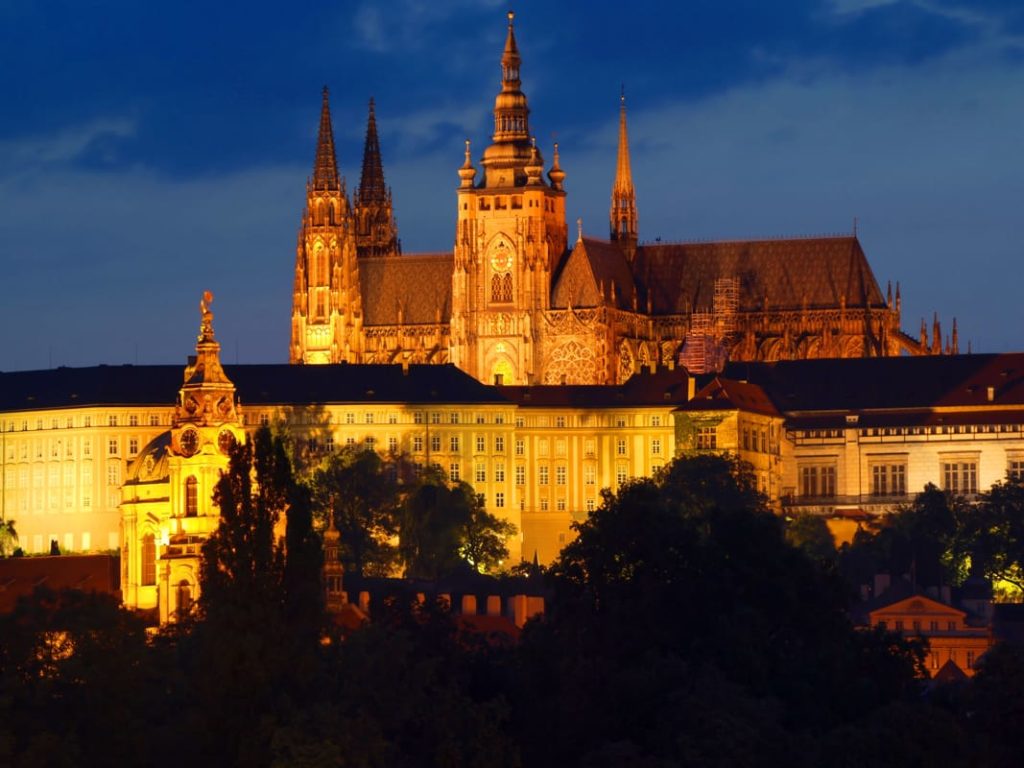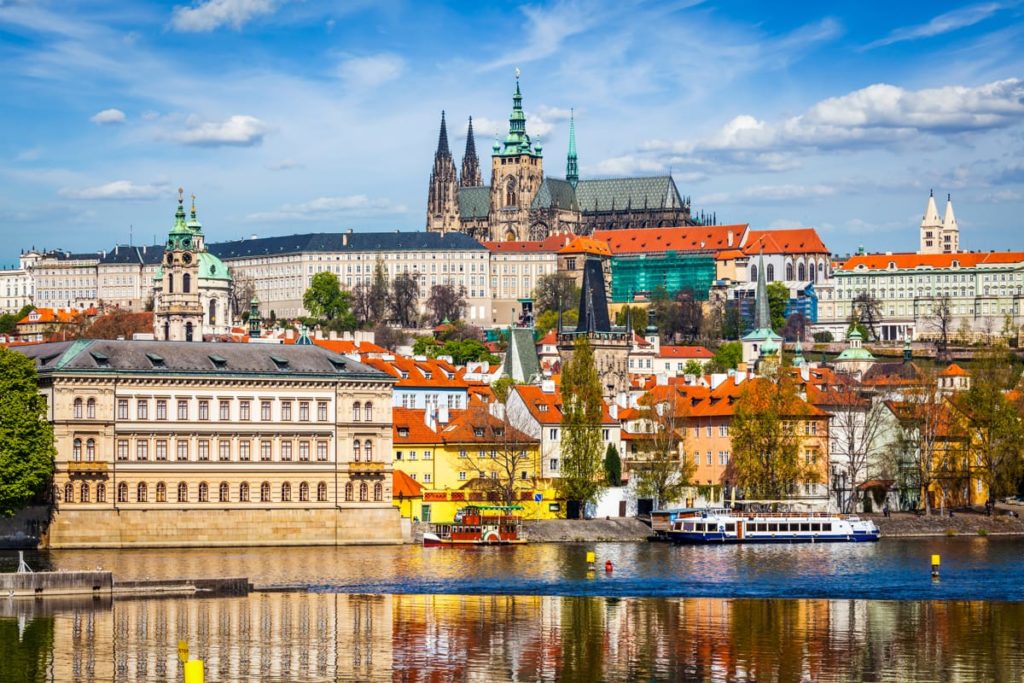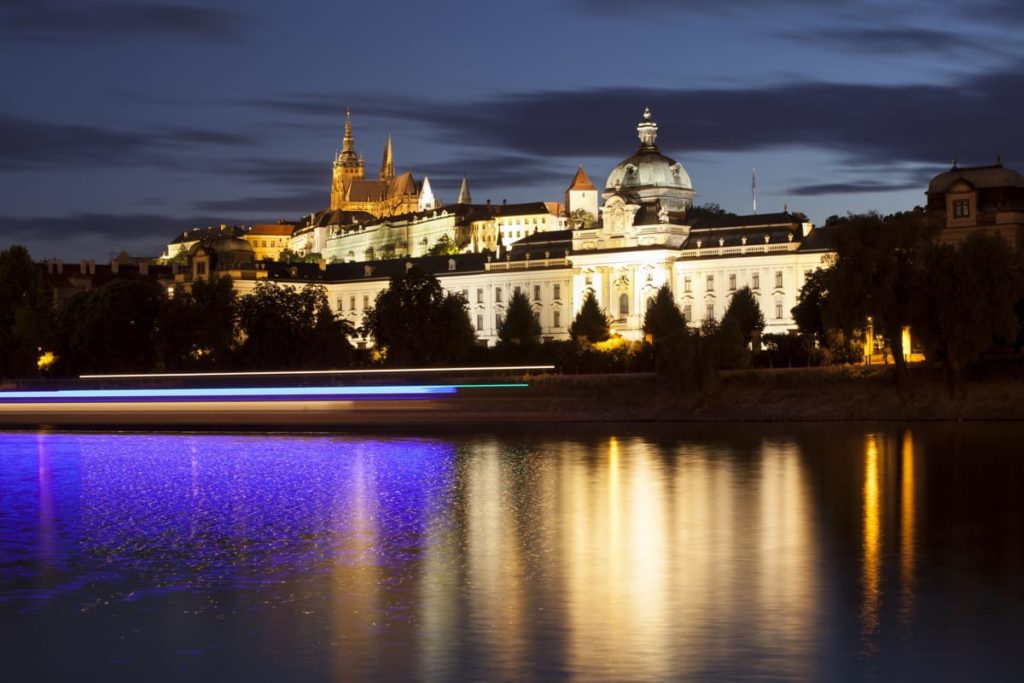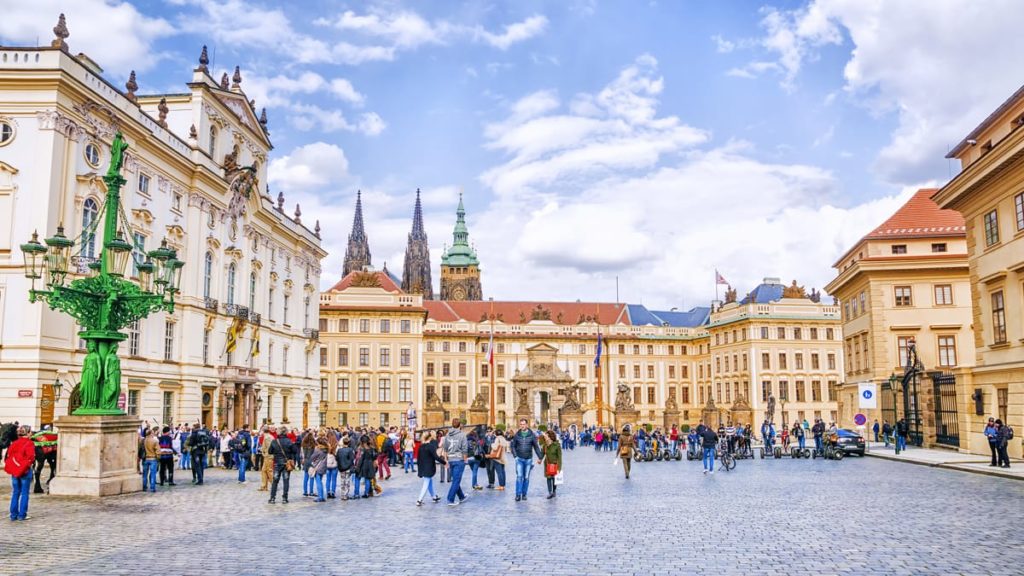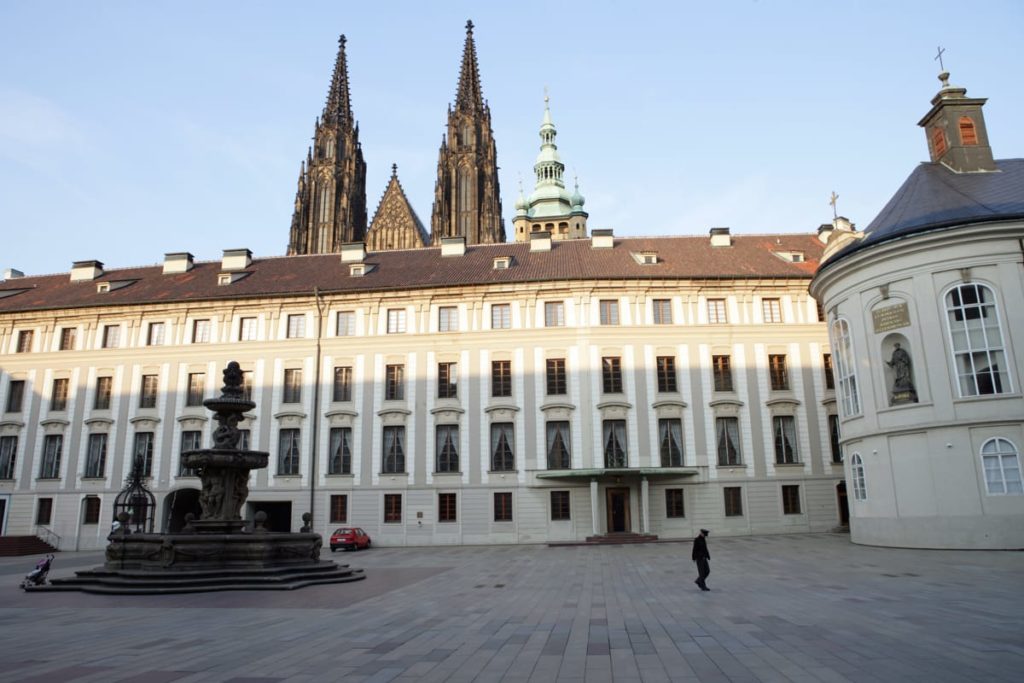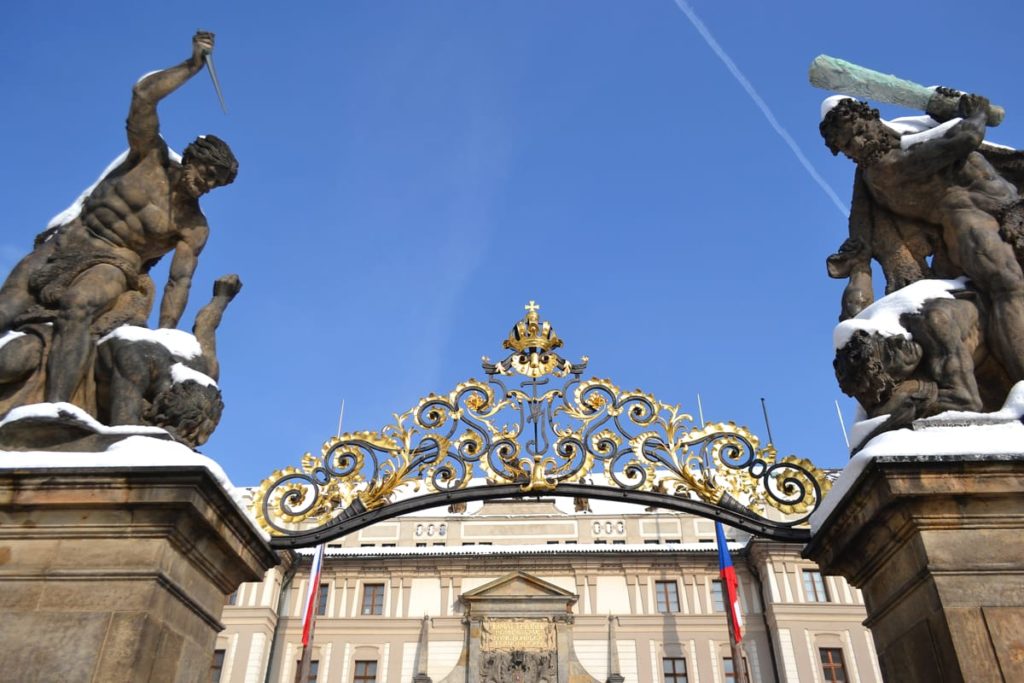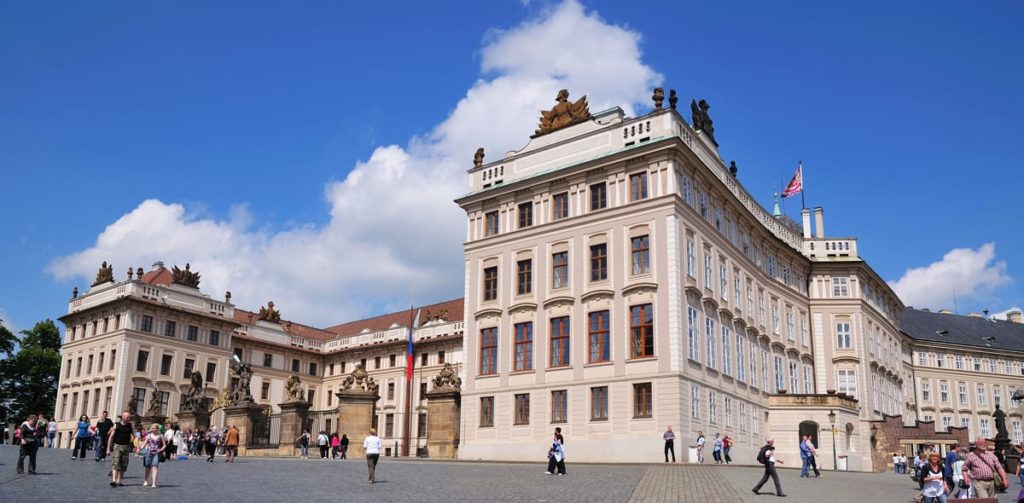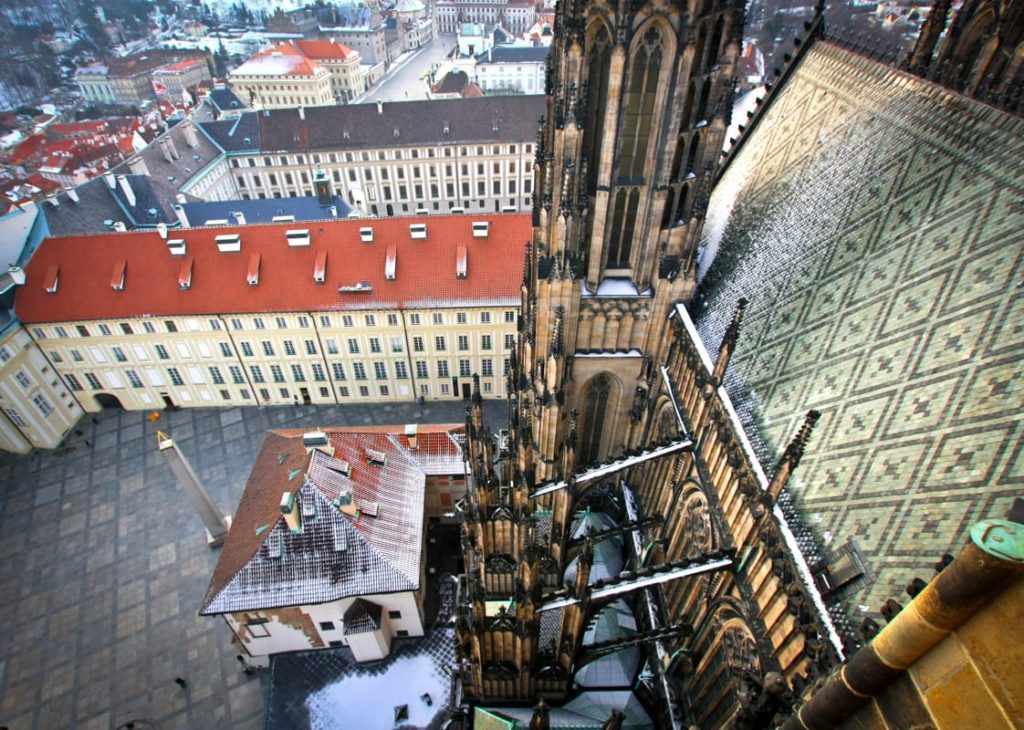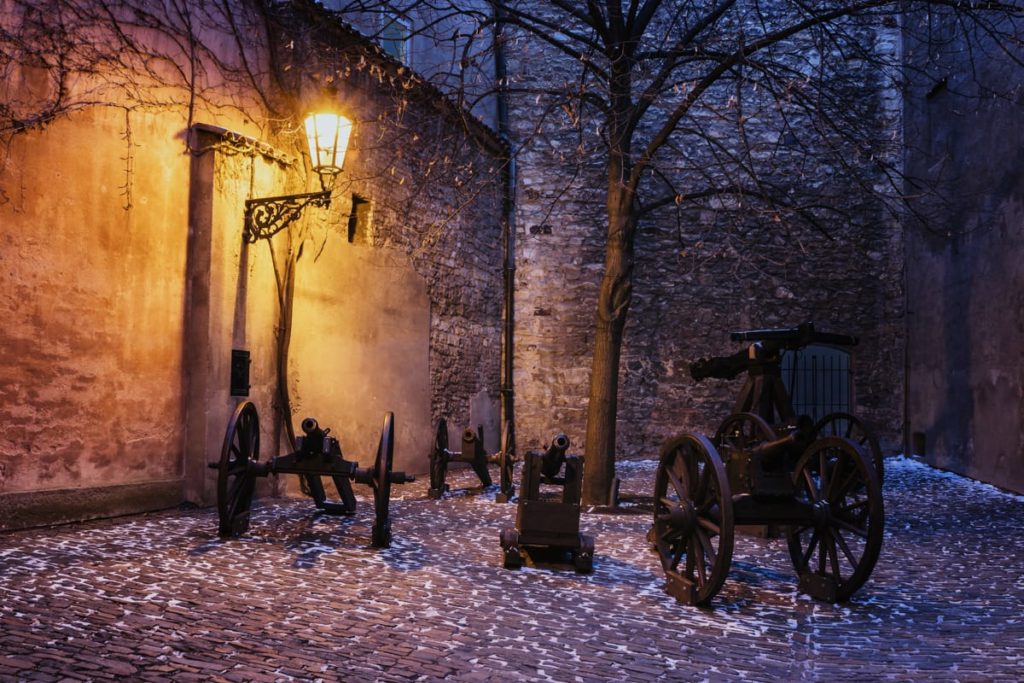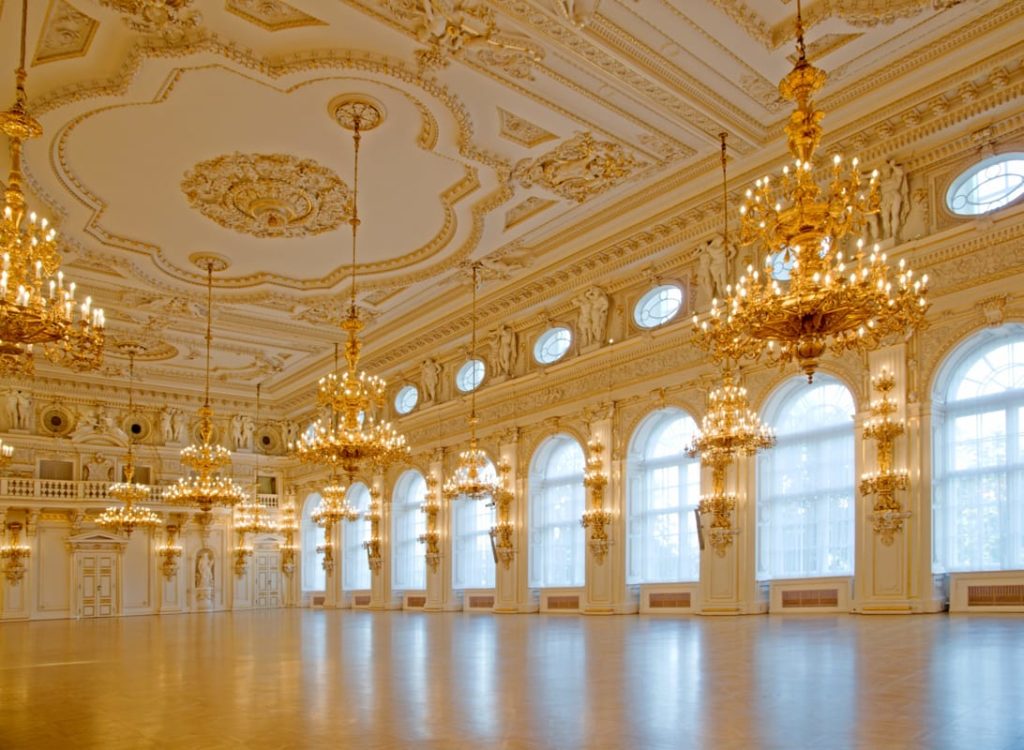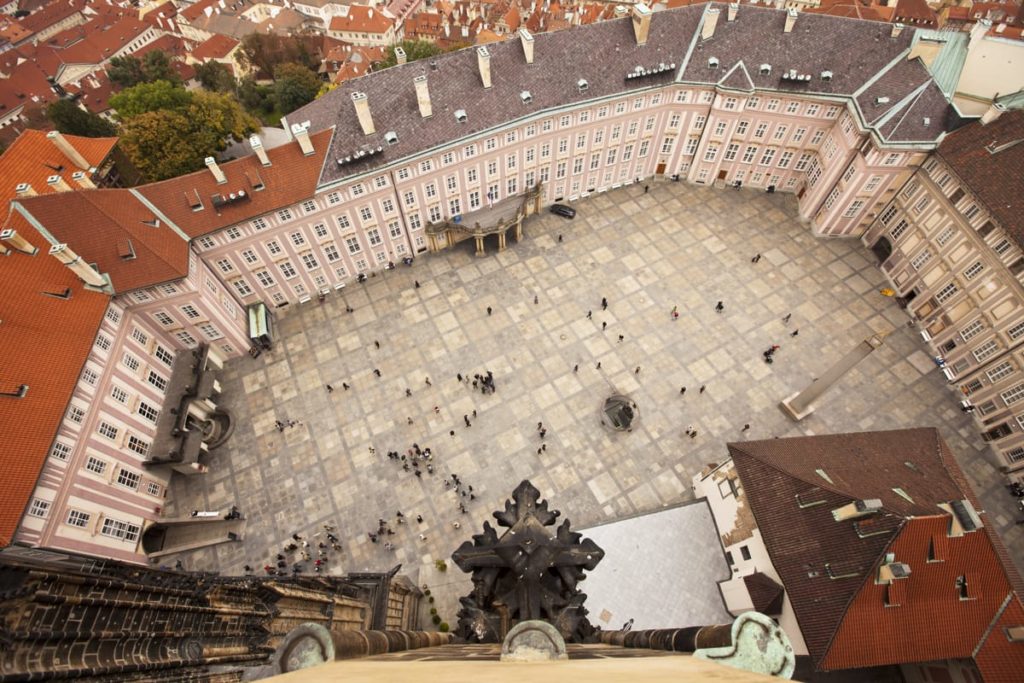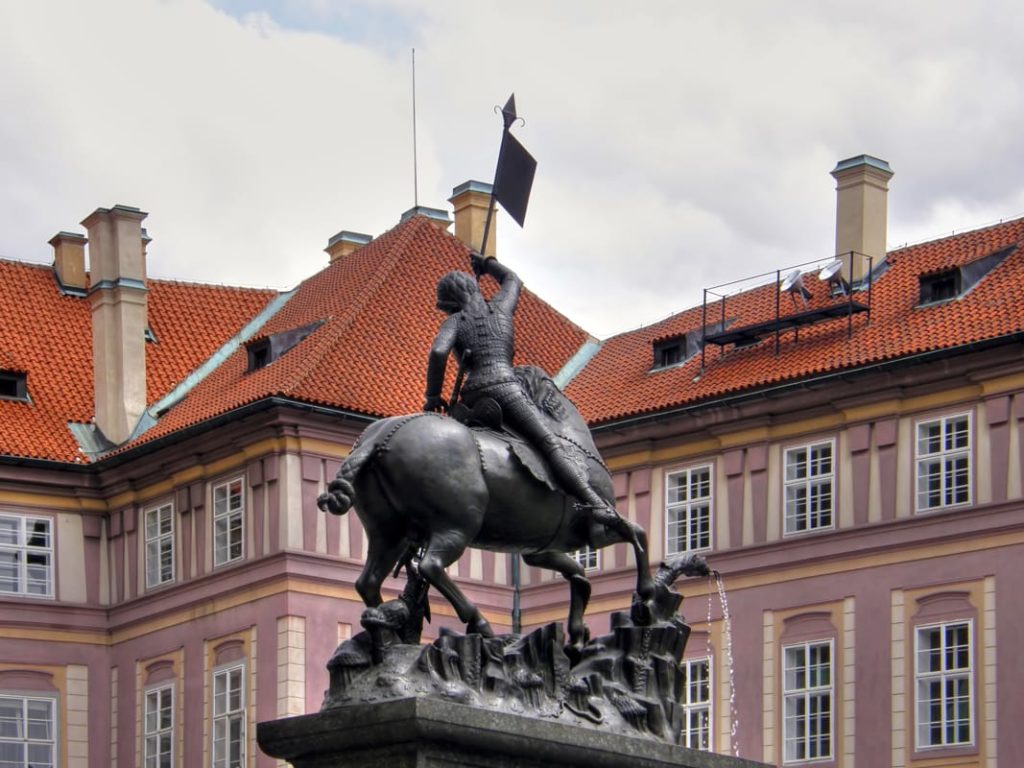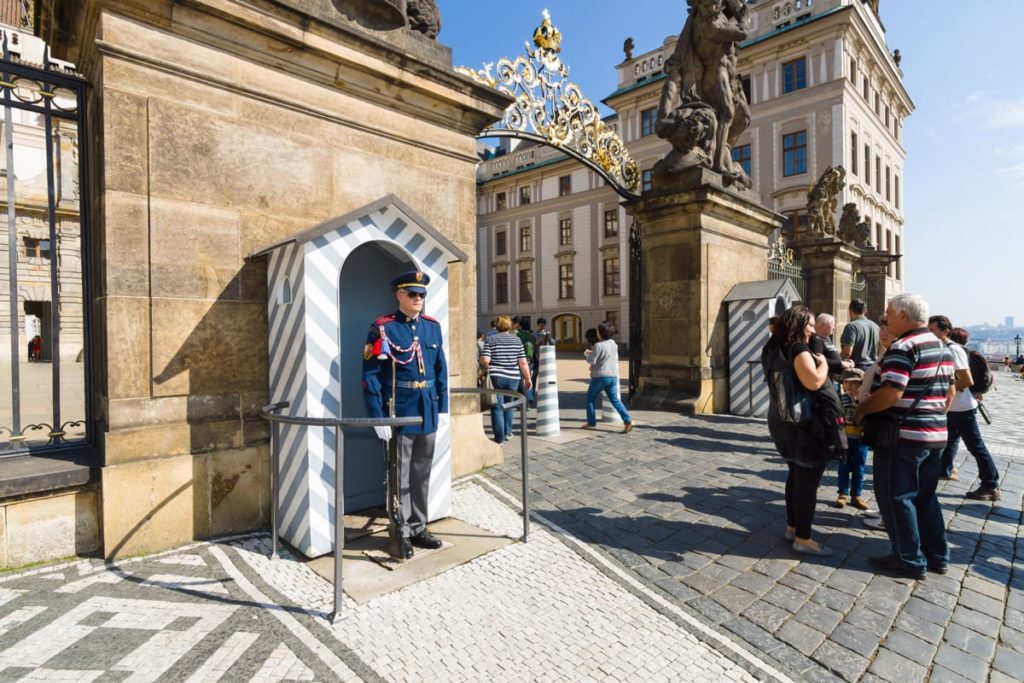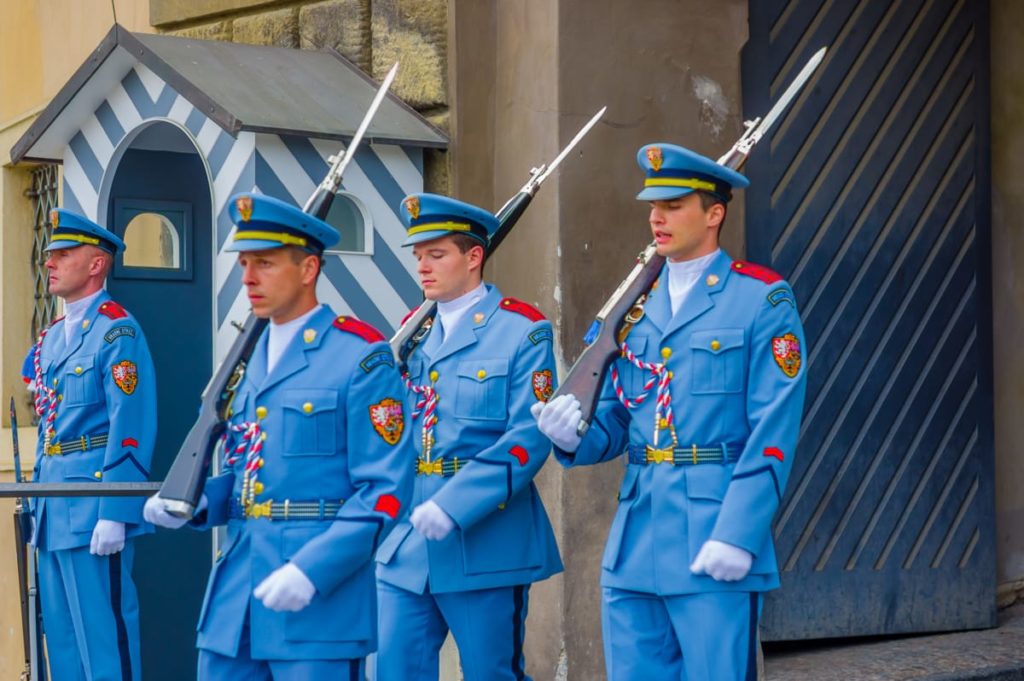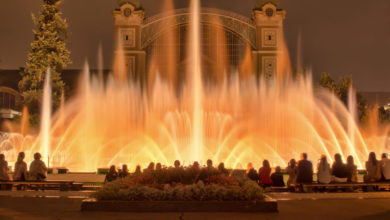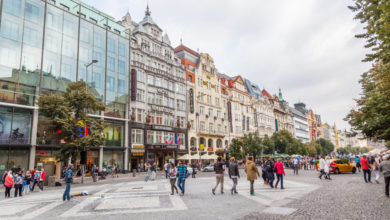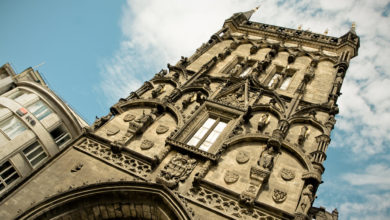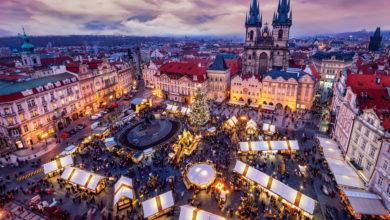Pražský hrad

The Largest Castle Area in the World
Prague Castle is one of the most visited and most important spots in the entire city, undoubtedly the jewel of the Czech capital. The Castle is an ancient symbol of Czech lands and was most likely founded around the year 880 by Prince Bořivoj. The Castle itself is like a small town, and according to the Guinness Book of World Records, it is the largest coherent castle complex in the world. There are over 500 rooms, while some rooms are used as offices, representative halls, museums and exhibitions. It covers an area of 70,000 square metres and is still in use today.
The complex itself is located on the top of a hill along the left bank of the Vltava River. The Castle itself might not look like a traditional castle because it spreads more horizontally than vertically.
The Seat of the President
Prague Castle is the seat of the President of the Republic. It is also the historical and political centre of the city and our state. Two monumental statues of battling Titans over the front gate set the mood as you enter into the vast Castle complex, which includes a palace, three churches, royal stables, a monastery and of course, the manicured surrounding gardens. Supreme and towering over Prague is the magnificent and huge St Vitus Cathedral.
Attractions
All around the Castle are points of interest. For example, the “Golden Lane” is a series of small shops that once served as housing for the palace guards; the Old Royal Palace with its beautiful late Gothic vaulted roof, which is one of the oldest extant parts of the Castle; the Basilica of St George; and the museum of Czech history housed in Lobkowicz Palace. Also nearby is the Daliborka Tower, named for a nobleman once imprisoned there, and the Powder Tower, where alchemists once worked to try and turn metal into gold.
St Vitus Cathedral
One of the main sights attracting tourists is St Vitus Cathedral. This building dates to the 14th century and is constructed in a Gothic style, adorned with gargoyles. Inside the cathedral, visitors are treated to elaborate tombs, and you can even climb to the top of the bell tower, which is the tallest spot in the Castle and allows beautiful views of the entire city. The cathedral has side-chapels, the most remarkable of which is the Chapel of St Wenceslas with its walls of polished semi-precious stones.
St. George’s Basilica and Convent
Aside from the cathedral, there are another three churches to visit, with the most interesting being St. George’s Basilica. Its history can be traced back to 920 and still shows off an intriguing Romanesque character. It is part of St. George’s Convent, which was constructed about 50 years after the basilica, which is now part of the National Gallery, showcasing the best in Czech art.
Imperial Stables
These used to be the stables of Emperor Rudolph II, but they are now used for exhibitions. It is one of the most highly regarded galleries in the Czech Republic and regularly shows significant works of art in temporary exhibitions.
The Golden Lane
Some say that this is the most romantic place in the whole of Prague Castle. The alchemists of Emperor Rudolph II used to live and work and was also home to the world-famous Franz Kafka. Nowadays, the Golden Lane has retained its heritage, with several craftspeople plying their trade here – making it perfect for shopping.
Prague Castle Picture Gallery
This gallery houses the works of art owned by Emperor Rudolph II, renowned for being a passionate collector of art. Here you’ll find art from such famous artists as Titian, Rubens and von Aachen, as well as more than 100 other paintings (the whole collection numbers over 4,000, but not all are displayed at once). It can be found in the second courtyard of the castle.
The Powder Tower
The Powder Tower has served both as defences and as an alchemy room under Emperor Rudolph II nowadays though it houses an exhibition dedicated to the Palace Guard.
The Story of Prague Castle
The Story of Prague Castle is an exhibition chronicling the history of both the castle and the whole of the Czech Republic. It is on the Gothic floor of the Old Royal Palace, and access can be gained through the 3rd courtyard, just next to St. Vitus’ Cathedral.
The Riding School
Despite its name, this building has not been used as a riding school for many years. In fact, it is now an exhibition hall – the largest in the Czech Republic – houses a number of interesting temporary exhibitions all year round.
The Royal Summer Palace of Queen Anne
This is the most distant palace from the castle and was built in the 16th century by Ferdinand I for his wife. Fans of architecture will love its beautiful Renaissance design, although you can only go inside when an exhibition is on.
 Changing of the Guard
Changing of the Guard
This is a ceremony that takes place at the Castle every day from 5 am until 11 pm. The changing of the guard at noon also includes a fanfare and a flag ceremony in the First Courtyard.
How to Get to Prague Castle
Getting There on Foot
As a starting point, we recommend the Metro station Malostranská (line A), located just below Prague Castle. From there, you will step up on the Old Castle Stairway (Staré zamecké schody) and directly to the Castle gate. Another recommended option is from Lesser Town Square via Nerudova Street, which is a bit of a steep walk. You will end up in front of the main entrance to the Castle. This option is not suitable for less energetic seniors.
Getting There by Tram
If you prefer not to do such a steep walk up Old Castle Stairway, you can take either tram No.22 up to the hill to get off at the stop for Pražský hrad. If you intend to explore Hradčany (Strahov monastery or Loreta) first, stay on the tram until Pohořelec, the second stop after Pražský hrad.
Other tram stops include:
• Královský letohrádek (Belvedere) – start with the Royal Garden, Belvedere and Ballgame Hall, then cross the Deer Moat bridge to get to the Second Courtyard. The Royal Garden and Deer Moat are closed from November through March.
• Pohořelec – walk to the Castle through Hradčany, and you will arrive at the main entrance.
You can wander through the castle grounds and gardens without a ticket but you’ll need a ticket for all of the main historic buildings.
Entrance Fees
Entrance fees are required for a few selected areas, but visitors can walk freely through the grounds and even into the larger portion of the cathedral. A collective ticket can be purchased at the information office. Allow a minimum of four hours for a visit. Other information can be found on the official website for Prague Castle.
There are six different tickets which are valid for two days.
Long visit ticket (price for adult 350 CZK, concession 175 CZK, family 500 CZK): Cathedral of St Vitus, Old Royal Palace, permanent exhibition “The Story of Prague Castle”, St George‘s Basilica, Convent of St George, National Gallery, Golden Lane with Daliborka Tower, Prague Castle Picture Gallery, Powder Tower, Rosenberg Palace.
Short visit ticket (price for adult 250 CZK, concession 120 CZK, family 300 CZK): Cathedral of St Vitus, Old Royal Palace, St George‘s Basilica, Golden Lane with Daliborka Tower Exhibition “The Story of Prague Castle”, Prague Castle Picture Gallery, Powder Tower, Rosenberg Palace, Great South Tower of Cathedral of St Vitus.
Convent of St George (price for adult 150 CZK, concession 80 CZK, family 200 CZK)
Powder Tower (price for adult 50 CZK, concession 25 CZK, family ticket 70 CZK)
Prague Castle Gallery (price for adult 150 CZK, concession 80 CZK, family 200 CZK)
Story of Prague Castle (price for adult 140 CZK, concession 70 CZK, family 200 CZK)
Prague Castle tickets are valid for two consecutive days.
The early morning is the least crowded time to visit Prague Castle.
Opening Hours
During the summer season (April – September), the Castle complex is open daily from 5 am to midnight. Places, where tickets are required are open from 9 am to 6 pm. Together with the Deer Moat, Prague Castle Gardens are open according to the months: April and October from 10 am to 6 pm; May and September from 9 am to 7 pm; August from 9 am to 8 pm; June and July from 9 am to 9 pm. During the winter season (October – March), the Castle complex is open daily from 6 am to 11 pm. Places where tickets are required, are open from 9 am to 4 pm. Prague Castle Gardens, including the Deer Moat and the Riding School Terrace, are closed.
Prague Castle Guided Tours
Tours are available in two main forms. The long tour includes the Old Royal Palace, the exhibition entitled “The Story of Prague Castle”, St George’s Basilica, the Convent of St George, the National Gallery, Prague Castle Picture Gallery and Golden Lane with Daliborka Tower. The short tour includes the Old Royal Palace, St George’s Basilica and Golden Lane with Daliborka Tower. All tours are guided by professionals and can be heard in English, German, French, Spanish, Italian and Russian. One-hour guided tours are available daily except Monday and cost 400 CZK for up to five people, plus 100 CZK per additional person. You can also rent an audio guide for 150 CZK for two hours from the information centres.
Do not miss Golden Lane but, if you are tempted do some shopping there, be aware this is the most expensive shopping area in the whole of Prague, followed by Pařížská Street. Dining or even lunch at Prague Castle can be very nice, but is certainly very expensive too. If you are visiting the Castle with children, you might wish to visit the Toy Museum. The Information Center is located in the third courtyard.
History of Prague Castle
The castle itself dates back to the 9th century but has been added on several occasions. Therefore, the castle includes several different architectural styles, including a Romanesque palace built in the 12th century and a rebuilding effort led in the 14th century resulted in a Gothic style. The early medieval castle is made of clay and stones and completed with a traditional moat. The castle has also seen several prosperous times, including Emperor Charles IV’s rule in the middle of the 14th century. It became an imperial residence and the seat of the ruler of the Holy Roman Empire. Another important time in the castle’s history came in 1483 when new fortifications were made. After a fire in the year 1541, an enlargement of the castle took place in the 16th century. The last great building effort took place in the second half of the 18th century; however, when the capital was moved to Vienna, it began to fall on hard times. Today, reconstruction is still going on to make the entire facility open to all visitors. In addition, the castle is now the seat for the head of state; it also houses the crown jewels, the relics of the Bohemian kings, and Christian relics and important historical documents.

